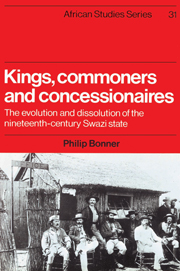 Kings, Commoners and Concessionaires
Kings, Commoners and Concessionaires Book contents
- Frontmatter
- Contents
- List of maps
- List of figures
- Preface
- Map 1 Modern Swaziland
- Map 2 Chiefdoms c. 1820
- 1 Introduction
- 2 The northern Nguni states 1700–1815
- 3 The conquest state 1820–1838
- 4 Factions and fissions: Mswati's early years
- 5 The balance tilts: Swazi–Boer relations 1852–1865
- 6 The deepening and widening of Dlamini power 1852–1865
- 7 Regency and retreat 1865–1874
- 8 Confederation, containment and conciliar rule: Mbandzeni's apprenticeship 1874–1881
- 9 The puff–adder stirs: Mbandzeni and the beginnings of concessions 1881–1886
- 10 The conquest by concessions 1886–1889
- 11 Conclusion
- Appendix
- Notes
- Bibliography
- Index
- KINGS, COMMONERS AND CONCESSIONAIRES
- Frontmatter
- Contents
- List of maps
- List of figures
- Preface
- Map 1 Modern Swaziland
- Map 2 Chiefdoms c. 1820
- 1 Introduction
- 2 The northern Nguni states 1700–1815
- 3 The conquest state 1820–1838
- 4 Factions and fissions: Mswati's early years
- 5 The balance tilts: Swazi–Boer relations 1852–1865
- 6 The deepening and widening of Dlamini power 1852–1865
- 7 Regency and retreat 1865–1874
- 8 Confederation, containment and conciliar rule: Mbandzeni's apprenticeship 1874–1881
- 9 The puff–adder stirs: Mbandzeni and the beginnings of concessions 1881–1886
- 10 The conquest by concessions 1886–1889
- 11 Conclusion
- Appendix
- Notes
- Bibliography
- Index
- KINGS, COMMONERS AND CONCESSIONAIRES
Summary
Despite a relatively long tradition of historical scholarship, the historiography of nineteenth-century South Africa is uneven in quality and in places disappointingly sparse. Within the realm of specifically African history, large areas await serious academic attention, and while a new upsurge of interest has been evident for much of the last decade, only a small proportion of the resulting researches has yet appeared in print. Much of the published African material is therefore still framed within settler, Afrikaner or liberal traditions, and is disfigured in many instances by a strong albocentric slant. The dominant assumptions have been of the backwardness and stasis of African societies, to which is often added their incapacity to shape history for themselves. Liberal writing has been no more immune from this spirit than studies cast in the settler–Afrikaner mould. Settler historians like Theal or Cory may have inveighed against the barbarity of blacks, and framed their accounts in terms of African aggression and deceit, but they did at least devote considerable space to African activities from which the outlines of a history emerge. Liberal historians by contrast have contented themselves with affirming the dignity and validity of African societies, and denouncing the violence and rapacity of whites, but almost invariably with the assumption that Africans were passive objects of history meriting little attention in themselves. Only with the publication of The Oxford History of South Africa in 1969–71 was a more Africanist dimension injected into liberal writing, yet this, while an important milestone in southern African studies, has not been backed up by the range of monographs that it might have been expected to inspire.
- Type
- Chapter
- Information
- Kings, Commoners and ConcessionairesThe Evolution and Dissolution of the Nineteenth-Century Swazi State, pp. 1 - 8Publisher: Cambridge University PressPrint publication year: 1983
